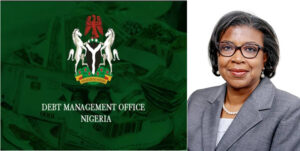
…Expresses Doubt On Ability Of Outgoing Govt To Remedy Deteriorating Situation,
…Recommends Budgetary Reform, Fiscal Prudence, Revenue Innovation As Rescue Strategies For Incoming Govt
By John Omachonu
From all indications, Nigeria’s debt sustainability, based on the recent figures released by the Debt Management Office, (DMO) for the last nine months, is hanging by a thin line, says Afrinvest.
According to the data, Nigeria’s public debt stock excluding Ways and Means (W&M) liability to the CBN rose by ₦1.3tn q/q to ₦44.1tn, the highest level on record, with domestic, accounting for ₦26.9tn and external, ₦17.2tn.
Specifically, between January and end of September 2022, the public debt profile increased by ₦4.5tn, with domestic borrowing accounting for 71.3 percent of the new increase.
Also, over the same period, FG’s borrowings via the W&M window also increased by ₦6.3tn to a cumulative sum of ₦23.8tn, bringing the total public debt stock as of Q3:2022 end to ₦67.8tn.
According to the Afrinvest analysts, “This is not surprising given FG’s dismal revenue performance over the period. For context, data from the Federal Ministry of Finance, Budget and National Planning (FMFBNP) revealed that the FG actual revenue grossed ₦4.2tn in 9M:2022 against the pro-rata target of ₦6.7tn.
Although actual expenditure was lower by 17.2% compared to the ₦11.6tn intended, the actual deficit, ₦5.3tn, was still 8.8% higher than projected. Hence, the resultant higher borrowings which grossed ₦10.8tn.”
Assessing the new debt milestone in light of key sustainability metrics set by the DMO, Afrinvest analysts say that based on the debt mix, debt as a percentage of GDP, and deficit as a percentage of GDP, “we submit that Nigeria’s debt sustainability strategy is hanging by a thin line. In terms of the debt mix (ex. W&M), we observed that the share of external debt increased in Q3:2022 by 10bps to 38.9% due to fresh external borrowings of ₦535.0bn, while the share of domestic borrowing fell 12bps to 61.1% despite fresh borrowings of ₦690.0bn.
However, by adding W&M liability to the debt stock, the external debt share fell to 25.3%, implying that the domestic debt component has breached the sustainable cap of 70.0% by 4.7ppts.”
However, annualising the 9M:2022 nominal GDP of ₦144.6tn, Afrinvest says the country’s “debt as a percentage of GDP is estimated to reach 35.2% by end of 2022 in a blue-sky scenario (2021: 32.6%) – a close shot from DMO’s sustainable mark of 40.0%.
“Also, we estimate that in a base case scenario, deficit to GDP rate would settle around 3.7% by year-end (2021: 4.2%), implying a sustained breach of the 3.0% cap stipulated in the 2007 Fiscal Responsibility Act.”
They also express worries over the debt-service-to-revenue ratio, a measure of liquidity, which remains disproportionately high at 83.0% as of Q3:2022 (2021: 96.0%).
Sadly, they further observe, is the economic sabotage, which has robbed Nigeria of the windfall gains from the oil price rally in 2022, while estimating that the debt service-to-revenue ratio could touch 91.8% by year-end (World Bank projection: 96.3%).
“In our view, the outgoing administration is less likely to implement any fiscal reform that could remedy the deteriorating debt sustainability situation in its remaining few months.
Hence, we posit that budgetary reform, fiscal prudence, and revenue innovation would be key if the next administration would rescue the weakening debt sustainability trend.